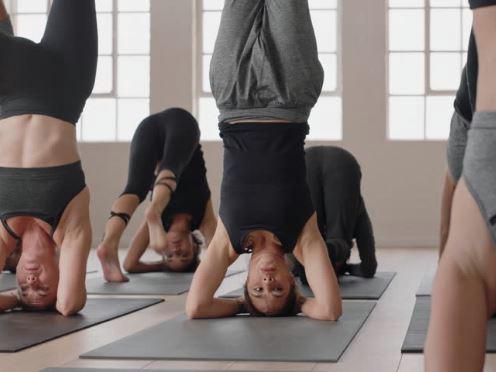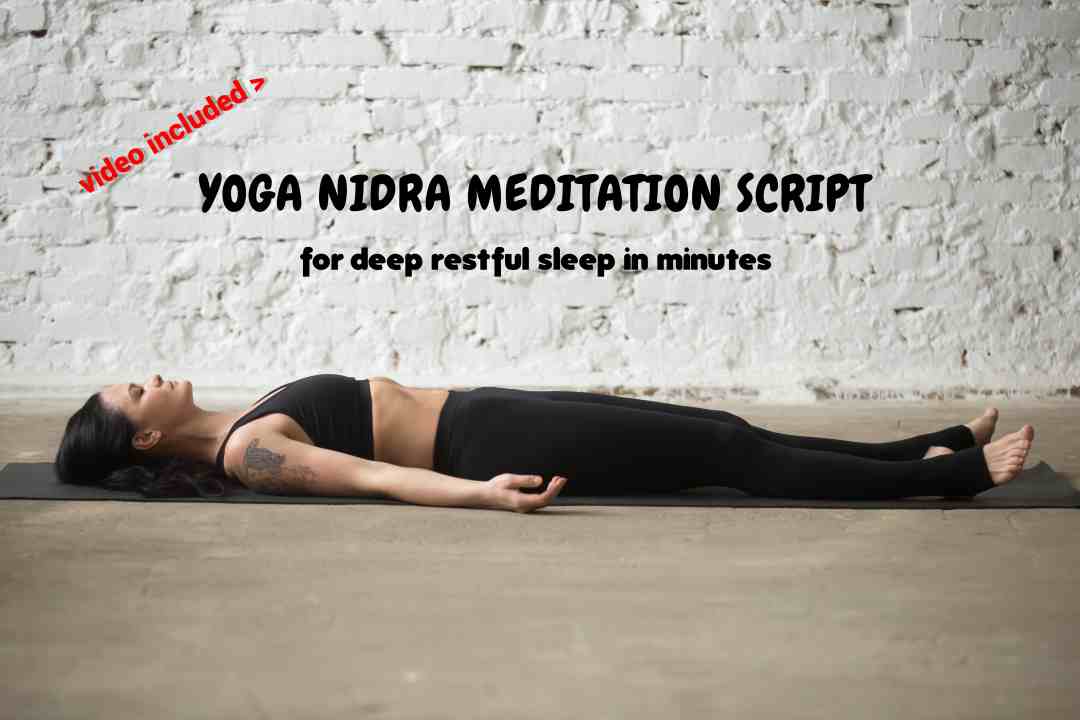Sirsasana also is known as the headstand pose which is practised as the first asana, after Pranayama and Surya Namaskar. It is one of the main postures in Hatha Yoga. Sirsasana is regarded as the ‘King’ of all 84,000 different asanas present in the Yoga book.
“Being in shape is not Yoga. Paying attention to what you’re doing when you’re doing it is Yoga.” – Jason Crandell.
As a child, I always looked up to people who performed headstands. It was intriguing to see how they could manage to do that. I always thought it was an impossible thing to do and only specially trained people could do it.
What I never knew as a yoga beginner, was that headstand emerged from yoga and also has a name, Sirsasana. Meaning of Sirsasana: In Sanskrit Sirsa = Head and Asana = Posture. Yogic sages practice this asana to build strength in their upper body and relax the mind through the flow of blood.
Before you attempt the Headstand (Sirsasana), practice the Dolphin for at least a few days or better still a week. This will make your arms and shoulders strong enough to perform the posture. Even after doing the headstand, it is recommended to continue doing the Dolphin as you will be able to do the headstand with ease and for a longer duration.
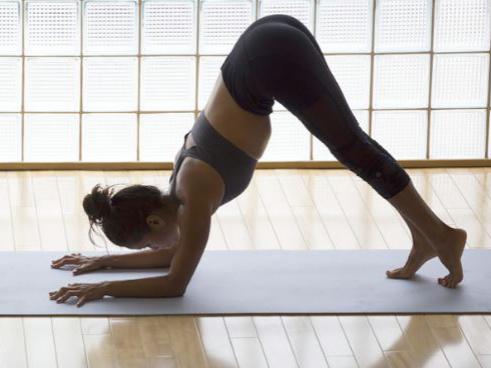
Dolphin – Headstand preparatory exercise for beginners
These steps will help you prepare for the headstand or Sirsanansa.
Step 1 (Child’s Pose)
To begin with, sit on your heels with your knees together. Measure your forearms by holding each elbow with the other hand. Bring the elbows down to the floor below the shoulders.
Step 2
Without moving your elbows bring the hands together to form a tripod kind of support on the floor. Interlock the fingers.
Step 3
Let the feet be where they are. While inhaling raise your hips and keep your head up. Straighten your legs.
Step 4
While you are exhaling, bring your arms, shoulders and head downwards towards the floor – make sure you do not move your lower arms.
Step 5
If it is comfortable and possible for you – bring your forehead down towards the yoga mat so that it is in front of your hands, keep your buttocks raised up.
In case it is strenuous for you to move forward as far as your arms can carry your weight. While inhaling deeply push back to the position of Step 3. This posture will strengthen your arms enabling you to carry most of your body weight while doing Headstand or Sirsanana.
Repeat Steps 3-4 up to 10 times.
Step 6
After the above relax for 1 minute in Child’s Pose.
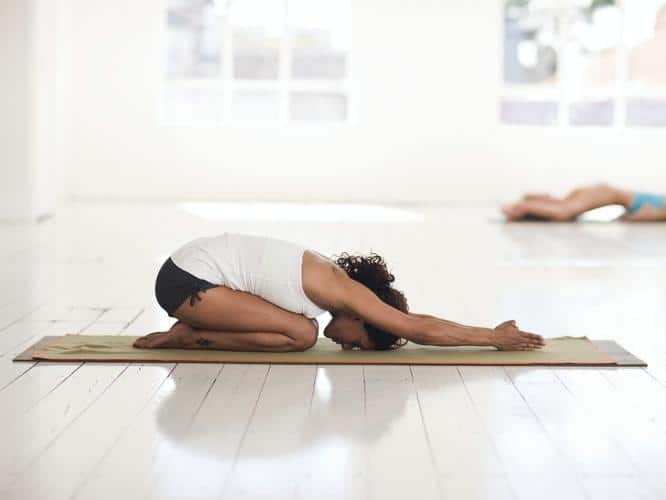
Step By Step Video to Guide you to do a Headstand (sirsasana)
Headstand or SirsaSana
Headstand or Sirsasana is called the King of Yoga poses because it has great benefits as it boosts memory and concentration. The very fact that you can balance yourself upside down makes you feel confident. However, practice it only after a thorough study of its techniques and precautions OR learn it under the supervision of a Yoga trainer if possible.
Headstand or Sirsasana is a gift to improve brain power and a healthy heart. To perform Sirsasana you don’t need to have any special flexibility or body muscles or strength. Just follow the basic step-by-step guidelines of headstand and soon you will stand as naturally on your head as you stand on your feet.
You may worry how can your vertebrae of the cervical region carry all your body weight. However, you should know more than half of your body weight will be on your hands and the balance weight is taken by the head. The crucial part is the neck has to be properly aligned with the spinal column.
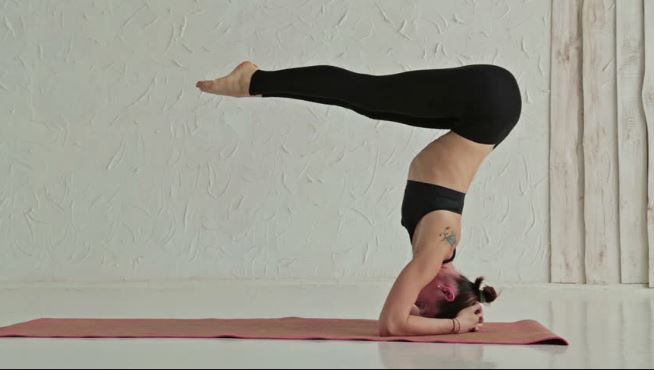
Headstand or SirsaSana – Coming into the position following the Eight Steps:
Starting Position before starting the Sirsasana or Headstand: Get into the Child’s Pose and relax your back and neck for a few minutes before you start.
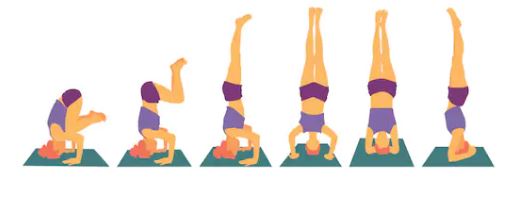
Step 1
Lean forwards, holding each hand taking it around the opposite side elbow and place your arms 8 inches or 20 cms away from your knees on the floor in front of you. Whereas, keep the buttocks resting on heels.
Step 2
Don’t move the elbows, however, move your hands forward to interlock your fingers. This makes a triangular base of your elbows and hands – putting equal weight on all three points of the triangle.
Speak to yourself and say “my arms are my legs” to help you put maximum weight on the tripod you have made.
Step 3
The third step is to bend over and place your the topmost area of your head onto the floor. While doing so press firmly on the tripod of the hands, elbows and let your hands support your head firmly.
Tip: Do not move the elbows and keep your neck straight.
Step 4
Lift your hips without moving your head or elbows – stretch your knees to make them straight with your feet on your toes. Your weight should be transferred to your elbow while they remain stationary.
Step 5
Walk with your feet forward while keeping the knees straight. As soon as the feet come closer to the head, feel that your back is straightening. Keep walking until the hips are directly above your head. Keep supporting and adding weight on the tripod of your arms and elbows.
Step 6
Now carefully lift the feet off the floor while bending the knees towards the chest. make sure, to use your lumbar and abdominal muscles while doing so. Bring your feet up to the buttocks and try holding this position while you straighten your back.
Tips: Never try and jump or kick up your body. Do not try to straighten your legs so that you don’t lose balance while doing this and fall on your back.
Instead, slowly tilt your pelvis balance backwards until you find the point of balance in your lower back. When you do this – the weight of your bent legs is balanced by the weight of your hips and buttocks. Maintain the support on your forearms and hands and elbows. Breathe rhythmically and hold this half headstand position for 1 minute.
Step 7
While you keep your knees bent together and also close to each other, straighten the hips slowly until the bent knees are pointing upwards to the ceiling or sky. Feel that your hips are hinges that are opening slowly. Never be in a hurry to take this position.
Maintain the concentration on your elbows and make sure they don’t lift off the floor. Shift your focus on your lower back, making sure that your body doesn’t topple either side – nor backwards or forwards.
Step 8
Straighten your knees while bringing your feet up. Breathe slowly while keeping the weight of your body on your elbows.
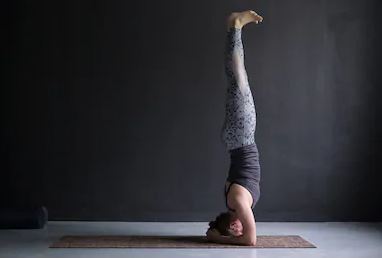
Holding the Headstand (Sirsasana)
Start holding the Sirsasana for 5 seconds and gradually increase the time to 15 minutes. The optimum time to hold the headstand (sirsasana) is 5 to 10 minutes daily. Make sure you keep your breathing rhythmic and slow while you are in the position. The weight continues to be on the elbows.
How to come out of the Headstand (Sirsasana) position?
Firstly, you need to be very slow and careful while bringing your body down from the pose it is in. Then, follow these steps below that will help you to come out of this pose, back to the starting point.
- Reverse the procedure of going up by first bending your knees, bringing them back into your chest.
- Then, bend your hips bringing your feet back to the floor.
- Bring your buttocks onto the feet.
- Lastly, relax in the Child’s Pose. Do not lift your head off the floor quickly.
- Lie down on your back in Savasana.
The benefits of Headstand or Sirsasana
The idea of going upside down on your head may not be appealing to most people. In fact, this inversion can really be scary for certain individuals, like you and me.
However, the “upside” of falling into a headstand or sirsasana (upside-down position) actually helps to boost your morale and render a new perception in your life.
Esteemed yoga teacher, B.K.S Iyengar, calls Sirsasana the ‘King of yoga postures’ because of its magical and wonderful effects that it has on your mind, body, and spirit.
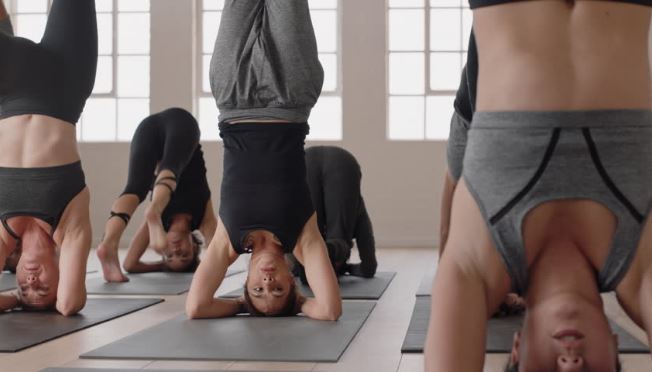
This pose offers Physical and Mental benefits to your body and mind.
Physical Benefits:
- If you do Sirsasana Or Headstand regularly you have a slower heartbeat and slow rates of respiration – an indicator of the flexible and stronger circulatory system.
- Richer and better blood flows into the spinal cord, brain and sympathetic nervous system. Therefore all body functions are enhanced. Disorders of the eyes, ears, nose and throat improve.
- If you have varicose veins you will find relief after practising Headstand as the stagnant blood tends to drain from the lower part of the body.
- Headstand (sirsasana) also relieves you from renal colic and stubborn constipation.
- The pressure on the lower back is released. This is so because during the headstand the lower back is released off the pressure.
- The Headstand (Sirsasana) also combats Asthma and dropped stomach.
- It helps warm up the extreme tips of your toes.
Mental Benefits:
- Headstand (shirshasana) helps boost memory and intellectual capacity.
- Improves concentration.
- Benefits eyesight and hearing.
Spiritual Benefits of Sirsasana:
There are many spiritual benefits of Headstand (sirsasana):
It helps in keeping up brahmacharya*. The seminal energy is transferred into the Ojas Sakti ( the spiritual force developed through the creative power of celibacy and yoga practice (Sadhana). In other words, it is called sex sublimation.
The seminal energy flows into the Ojas Sakti and flows towards the brain for being stored up as a spiritual force which can be further used for contemplative purposes – Dhyana (Meditation).
One can derive great benefits by meditating after a headstand. You can even hear mystic sounds (Anahata sounds) distinctly. You cannot fathom the benefits and advantages you can derive from the Sirsasana Pose or Asana. If you practise it you should not have frequent copulation (Sexual Intercourse).
“This is a panacea, a cure-all, a sovereign specific for all diseases. It brightens the psychic faculties and awakens Kundalini Sakti.”
Brahmacharya:
Brahman means- being the Divine Creator or the Higher Self. In Sanskrit ‘Brhman’ Means “Ultimate Reality” or “Divine Creator”.
Charya means “to move” or “to follow” thus a behaviour. Thus is means behaviour that leads to Brhman. It is associated with celibacy.
Brahmacharya is one of the Spiritual Rules (Yamas) by Swami Sivananda. Brahmacharya is encouraged so that the ones who practice Yoga can use their energy for a higher purpose rather than use it for sex. Therefore, it is called the “right use of energy”.
To Know if Yoga is good for seniors and Poses to follow click here
Common Mistakes:
Many of you might not be able to practice the headstand (Sirsasana) properly and find it difficult to perform it in the beginning. You are bound to make a few common mistakes and you might injure yourself as well. But if you can be aware of these common mistakes you can avoid unnecessary strain and pain. These common mistakes in the headstand lead to instability, discomfort and even injury.
However, do not give up on yourself and try to avoid these mistakes mentioned below.
- The weight of your body should not be on your head or neck.
- Avoid your back being arched with your legs dropping backwards.
- Hands and elbows are too wide in distance. Try to avoid this as it may affect your balance.
- Lastly, collapsed and hunched shoulders are a big no-no.
Who should avoid doing headstand or sirsAsana?
- Headstand (Sirsasana) is not suitable for people who suffer from neck ailments or scoliosis.
- People with heart conditions, vertigo, high blood pressure should be extremely cautious and avoid this pose.
- Children under the age of seven years should refrain from practising headstand (shirsasana). The reason being that their skull is freshly fused and can be still soft and prone to injury.
- If you suffer from a back injury or headaches, you should avoid performing this pose.
- Women when menstruating, should avoid this headstand as well.
- Pregnant women should not practice this pose or asana if they have never tried it before. If you are an expert and have been practising for a while then, you can continue practising this pose through your pregnancy.
- People with low blood pressure should not begin the pose until their blood pressure is normalized.
- If you suffer from glaucoma, then you should avoid the headstand (Sirsasana) as it can increase the pressure in the eyes.
Yoga Poses: Bridge Pose – Steps and Benefits of Setu Bandhasana
Did you know?
Those who engage or partake in spiritual yoga practice, use Sirshasana (Headstand) to redirect their sexual energies into higher spiritual energy called Ojas. This has proven to increase wellness and promote a positive aura. It helps to assist in heightening other spiritual yogic practices.
CONCLUSION
Headstand (Sirsasana) is a very beneficial posture provided you practice it properly, without excess mental or physical stress.
Practice this unique pose to experience a complete change in your body. However, do it not to boastfully display or to prove to others.
Why do I say this?
Because headstand (Sirsasana) at one point was considered something cool to do and to show off without realizing the consequences it could have on your body. Now that yoga has gained more awareness and become a lifestyle, you are more aware of the astonishing benefits that it has on your body and mind.
I highly advise you to learn headstand from a trained and proficient yoga teacher who has personal experience and a proper understanding of the techniques and breathing while performing it.
Therefore, with Sirsha asana (Sirsasana or Headstand), reap all the benefits that it offers to you and achieve a holistic, balanced and peaceful life.
Keep practising and do not give up!
Related Articles:
What is the Best Time to Do Sirsasana or Headstand? Can we di it in the Evening?
Fish Pose Matsyasana with Steps and Benefits
How to do Surya Namaskar for Weight Loss
Sivananda Yoga Quotes
How to do Laughter Yoga and its Benefits
What is the Ayurvedic Perspective on Fast Food
https://wellnessworks.in/surya-namaskar-king-yoga-poses-wellnessworks/
How to do the Lotus Pose (Padmasana) – Steps, Precautions, Variations

